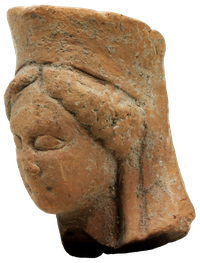Woman's head with polos and veil
Description: A wide low polos covers the head. A veil in soft folds falls over the asymmetrically parted hair. The face is oval, with a high forehead and full cheeks merging into a broad chin. The large, slightly protruding eyes are framed by narrow lids, the upper one forming a high arch, corresponding to the barely marked brows, while the lower lid is horizontal. The full lips are closed. The side view of the head shows the receding profile.
Commentary: Although the veil suggests that it is the head of a woman[1], as a parallel in Udine shows[2], Taranto clay sculptors (coroplasts) occasionally did not shy away from combining a head decorated in this way with the naked torso of a man posed for symposion. Thus we cannot be completely sure of the designation of Inv. T I-12 as female.
From the dimensions we can conclude that the figure was originally about 25 cm high. The head fragment does not allow us to decide whether the figure is standing or enthroned. The unusual asymmetry of the crown could have been created when the still malleable product was removed from the matrix; parallels show curved, unparted forehead hair or a middle parting[3].
Characteristic of Taranto workshops are the width of the face at eye level and the relatively large distance between the eyes themselves[4], as well as the accentuated chin, which sometimes even emerges strikingly from a receding profile[5], and the broad, low polos[6].
The plastic effect of the head, the heavy lower face with barely moving cheeks, the bulging eyeballs and full lips, as well as a hairstyle are characteristics of the Early Classical period[7].
The statuette was probably intended as a votive offering. An attribute that can be related to a specific deity, such as a cross torch to the chthonic goddesses[8], is not discernible.
Determination: Mid 5th century BC, from Taranto.
 |
 |
 |
|---|
[1] E. de Juliis – D. Loiacono, Taranto. Il Museo Archeologico (Mailand 1985), 338 f. fig. 404; E. Lippolis – S. Garaffo – M. Nafissi, Taranto. Culti Greci in Occidente I (Tarent 1995) 58 f. pl. 18, 1.
[2] The author considers the figure fragment to be female, M. Rubinich, Ceramica e coroplastica dalla Magna Grecia nella collezione de Brandis. Udine (Triest 2006) 208 no. 294.
[3] H. Herdejürgen, Die Tarentinischen Terrakotten des 6. bis 4. Jahrhunderts v. Chr. im Antikenmuseum Basel (Basel 1971) 38 no. 7 and 6 pl. 1; N. Poli, Collezione Tarentina del Civico Museo di Storia ed Arte (Triest 2010) 65 no. 32 pl. 74 and p. 82 f. no. 67 pl. 87.
[4] See heads such as: U. Hübinger – M. Menninger, Terrakotten der Westgriechen im Akademischen Kunstmuseum der Universität Bonn (Rahden/Westf. 2007) 94 f. fig. 13 f.; p. 97 fig. 17; p. 111 f. fig. 34.
[5] U. Hübinger – M. Menninger ibid. 137 figs. 64 b. c..
[6] H. Herdejürgen, Die Tarentinischen Terrakotten des 6. bis 4. Jahrhunderts v. Chr. im Antikenmuseum Basel (Basel 1971) 40 no. 12 and p. 43 f. nos. 22. 23, pl. 7.
[7] U. Hübinger – M. Menninger, Terrakotten der Westgriechen im Akademischen Kunstmuseum der Universität Bonn (Rahden/Westf. 2007) 131 no. 56; id. 138-140 no. 66; H. Herdejürgen, Die Tarentinischen Terrakotten des 6. bis 4. Jahrhunderts v. Chr. im Antikenmuseum Basel (Basel 1971) 43 no. 20 Taf. 5. On the high brow arches with horizontal lower eyelids ibid., 40 no. 12 pl. 7.
[8] N. Poli, Collezione Tarentina del Civico Museo di Storia ed Arte (Triest 2010) 149 no. 170 pl. 154.

